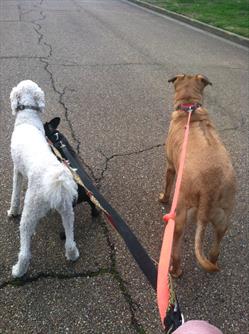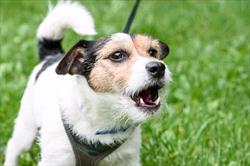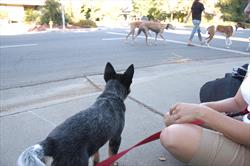Reactivity is a dog’s response to something in their environment which is triggered by anxiety, fear, or frustration. As much as reactivity can occur in different environments, it is commonly observed when a dog is restricted to being on leash. There is no quick fix when it comes to reducing leash reactivity. Have patience for your dog and the learning process.
Photo courtesy of Christine Calder, DVM, DACVB

Photo courtesy of Christine Calder, DVM, DACVB
What is Leash Reactivity?
Reactivity is a dog’s response to something in their environment which is triggered by anxiety, fear, or frustration. Though it is not limited to these behaviors, the dog may express their concerns by barking, growling, lunging, jumping up, and pulling. As much as reactivity can occur in different environments, it is commonly observed when a dog is restricted to being on leash.
Frustration is not solely a human emotion; dogs can feel it too. Owners may become frustrated because they cannot stop the unwanted behavior. Dogs are equally as frustrated that owners do not understand what the dogs are trying to communicate.
Who or what is often the target of leash reactivity?
This list can be endless! Any person, animal or “thing” in a dog’s environment can become the target of reactivity. What may evoke fear for some, may not for others. It is important to evaluate each dog as an individual and take their communication seriously. We may think their reaction is nonsense, but to them a real threat exists. Let’s take a closer look at a few scenarios to better understand.
Example 1
You take your dog for a walk when you encounter a balloon. It is flying away when your dog spots it. Your dog barks, dodges in the opposite direction, and tries to hide behind you. The body language displayed is fear!
Example 2
You take your dog for a walk when another dog comes racing to the fence, barking intensely at you and your dog. Your dog’s eyes become large. Growling and barking begins as your dog pulls hard towards the other dog. Again, the body language displayed is fear.
In both examples your dog was restricted from gaining access or getting away, causing frustration, making the dog’s reaction worse.
Adobe stock photo

Adobe stock photo
What role do humans play in leash reactivity?
Whenever dealing with a behavior problem the number one priority is to keep your pet feeling safe. Step one is identify the motivation for the behavior, so that the best treatment can be applied. Techniques that could harm the animal or make the behavior worse should not be used. When it comes to animal emotions, avoid making assumptions about their motivation. Rely on body language to understand canine communication.
Short-term treatment of leash reactivity
Avoid triggers.
Take a different route, walk on the opposite of the street or walk at different times. Avoidance can become a short-term or long-term solution.
Avoid punishment.
Punishment can be unintentional but is still punishment by definition. Techniques such as hitting and using a shock collar are forms of punishment as well as shouting “no” and “leave it.” If the dog perceives the technique as unpleasant, painful or frightening it is punishment. The risks outweigh the benefits.
Use a management tool.
Set your dog up for success by using tools that allow you to redirect and increase opportunities to reward good behavior. Tools such as a front-leading harness or a head halter helps maximize leash control and minimize discomfort. Check with a professional for specific instructions, on using these tools.
Use treat rewards!
Arm yourself with a pouch of tasty treats. When your dog encounters something scary offer a few treats for free. You are not rewarding their fear, you are making new, happy associations.
Long-term treatment of leash reactivity
Don’t be afraid to get more help.
It is important to know your dog and know your limits. If you are not achieving success and things are getting worse, ask for help. Speak with your veterinarian to determine the next steps. Medications may be needed or you may be referred to a veterinary behaviorist or other training professional for assistance.
Be patient.
It can take days, weeks, or months to see improvements. With time you will feel more confident and your dog will be less fearful. The goal is for your dog to look to you for guidance and a treat instead of reacting.
Courtesy of CattleDog Publishing

Courtesy of CattleDog Publishing
Set up training scenarios.
You cannot predict every situation, but you can purposefully set up scenarios for behavior modification.
There is no quick fix when it comes to reducing leash reactivity. Have patience for your dog and the learning process. Be kind, gentle, and fair in your approach. Regroup when necessary and don’t be afraid to try again.